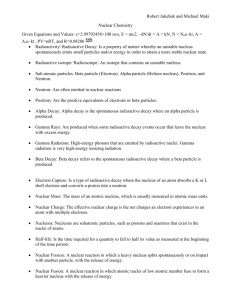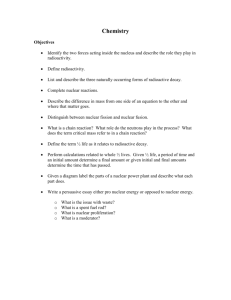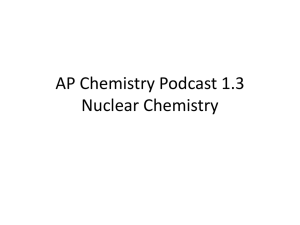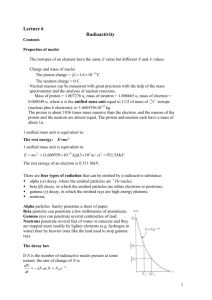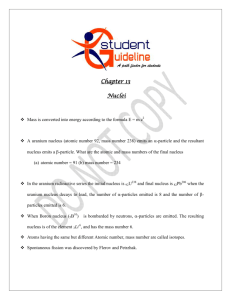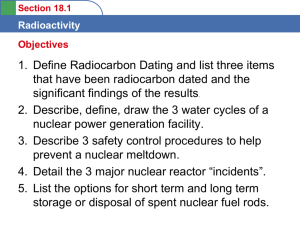Chapter 19. Radioactivity - Nuclear Chemistry
advertisement
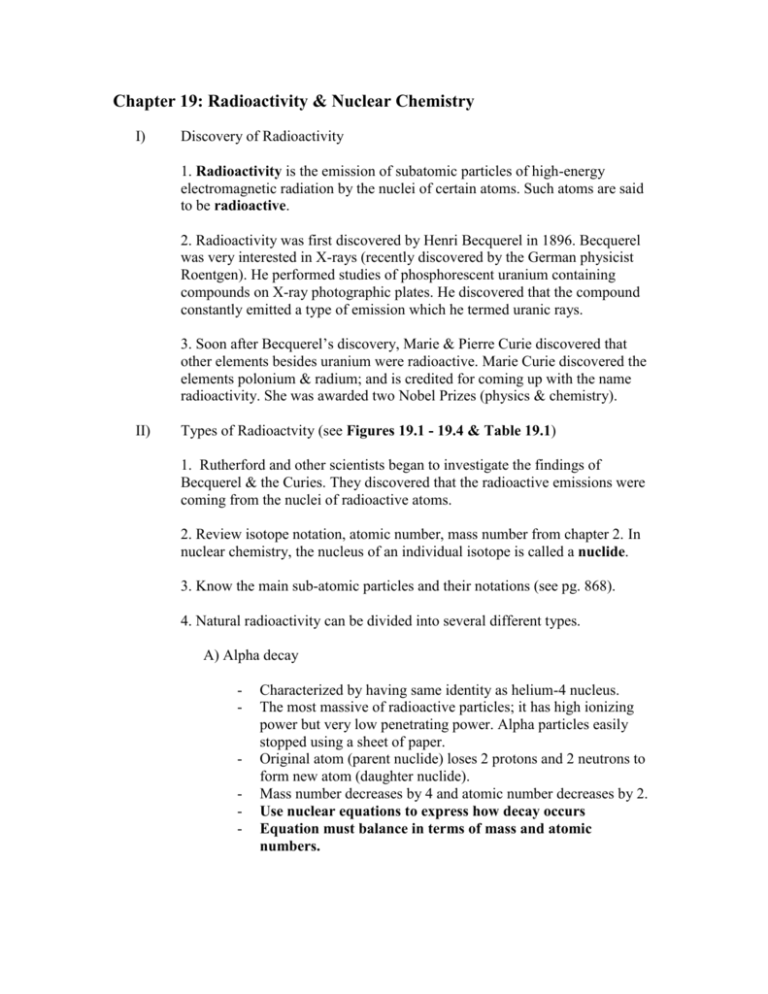
Chapter 19: Radioactivity & Nuclear Chemistry I) Discovery of Radioactivity 1. Radioactivity is the emission of subatomic particles of high-energy electromagnetic radiation by the nuclei of certain atoms. Such atoms are said to be radioactive. 2. Radioactivity was first discovered by Henri Becquerel in 1896. Becquerel was very interested in X-rays (recently discovered by the German physicist Roentgen). He performed studies of phosphorescent uranium containing compounds on X-ray photographic plates. He discovered that the compound constantly emitted a type of emission which he termed uranic rays. 3. Soon after Becquerel’s discovery, Marie & Pierre Curie discovered that other elements besides uranium were radioactive. Marie Curie discovered the elements polonium & radium; and is credited for coming up with the name radioactivity. She was awarded two Nobel Prizes (physics & chemistry). II) Types of Radioactvity (see Figures 19.1 - 19.4 & Table 19.1) 1. Rutherford and other scientists began to investigate the findings of Becquerel & the Curies. They discovered that the radioactive emissions were coming from the nuclei of radioactive atoms. 2. Review isotope notation, atomic number, mass number from chapter 2. In nuclear chemistry, the nucleus of an individual isotope is called a nuclide. 3. Know the main sub-atomic particles and their notations (see pg. 868). 4. Natural radioactivity can be divided into several different types. A) Alpha decay - - Characterized by having same identity as helium-4 nucleus. The most massive of radioactive particles; it has high ionizing power but very low penetrating power. Alpha particles easily stopped using a sheet of paper. Original atom (parent nuclide) loses 2 protons and 2 neutrons to form new atom (daughter nuclide). Mass number decreases by 4 and atomic number decreases by 2. Use nuclear equations to express how decay occurs Equation must balance in terms of mass and atomic numbers. 2 B) Beta decay - Particle emitted is an electron. Electron formed when neutron changes into a proton. Mass number remains fixed; atomic number increases by 1. Less massive than alpha particle; it has lower ionizing power but higher penetrating power. Need a metal sheet or wooden block to stop this guy. C) Gamma Ray Emission - Gamma radiation is a type of electromagnetic radiation. Gamma rays are very high energy photons. Gamma emission does not change either mass or atomic numbers Lowest ionizing power; highest penetrating power. Need thick lead shielding or thick slabs of concrete to stop these rays. D) Positron Emission - When an unstable nucleus emits a positron (the antiparticle of an electron). Positrons have the same mass as an electron, but are oppositely charged. Mass number remains fixed; atomic number decreases by 1. Ionizing & Penetrating powers similar to beta particles. E) Electron Capture - - III) This one is different in that a particle is absorbed by an unstable nucleus (all the others involve a particle being ejected from a nucleus). Electron capture occurs when a nucleus assimilates an electron from an inner orbital of its electron cloud. Positrons have the same mass as an electron, but are oppositely charged. Mass number remains fixed; atomic number decreases by 1. Kinetics of Radioactive Decay: Radiometric Dating 1. Radioactivity is a natural component of our environment. The soil, air, food and water all contain background radiation. 2. Every element with 83 or more protons in its nucleus is radioactive. 3. All radioactive nuclei decay via first-order kinetics (see chapter 13); so the rate of decay takes the form Rate = kN 3 4. The time it takes for one-half of the parent nuclides in radioactive sample to decay to the daughter nuclides is called the half-life. It is identical to the half-life concept covered for chemical reactions in chapter 13. 5. To calculate the half-life, we use the same equation as before. t1/2 = 0.693 / k 6. The integrated rate law for these problems follows the same format as found in chapter 13 (here Nt is number of radioactive nuclei at time t and N0 is the initial number of nuclei) ln (Nt / N0) = - kt IV) Nuclear Fission & Nuclear Fusion 1. The dawn of the “atomic or nuclear” age happened in the 1930s through the efforts of several scientists (Fermi, Meitner, Hahn, etc.). 2. Two terms that are routinely used, they are fission and fusion. 3. Nuclear fission involves the splitting of a heavier atom to yield a lighter nuclei and one or more particles. This is how a nuclear reactor plant generates electricity. 4. Nuclear fusion is the merging of two light nuclei to form a heavier one. The most common example of this is the Sun (a giant fusion chamber). Hydrogen bombs also use this process. 5. Although fusion provides about 10X the amount of energy per gram of fuel (versus fission), it is not yet practical to use this approach mainly due to the high temperature requirement.

